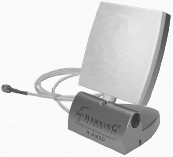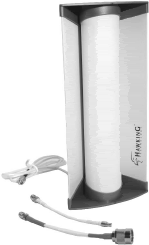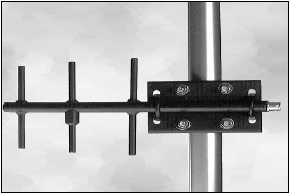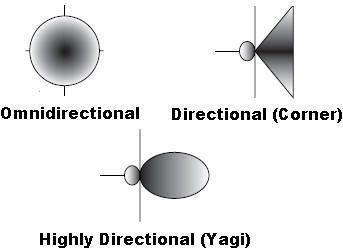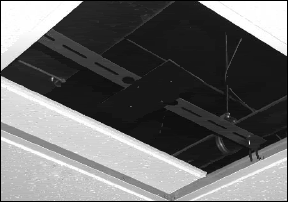For most indoor applications, you will choose one of three different types of antennas:
- An omnidirectional antenna.
- A directional antenna.
- A highly directional antenna.
An omnidirectional antenna radiates transmissions out and receives transmissions in from all directions, although not equally in all directions. Most of the antennas in this category are thin rods or long flat sticks.
 The Hawking H-AI6SI shown in Figure 1 is a good example of an indoor omnidirectional antenna that offers from 2 to 6dBi of gain (4x).
The Hawking H-AI6SI shown in Figure 1 is a good example of an indoor omnidirectional antenna that offers from 2 to 6dBi of gain (4x).
Meant for a 2.4 GHz b/g network, this vertically polarized antenna costs about $32.
Hawking has a line of wireless antennas that can be added onto your devices, and this particular one comes with both an RP-SMA and an RPTPC connector.
A directional antenna is one that has a wide dispersion of more than 80 degrees and less than 120 degrees.
They are often used for corner placement in a room to radiate to all portions of the room, and point in the direction of the main network path.
Directional antennas use parabolic reflectors, right angle deflectors, and panel deflectors.
Figure 2 shows the 2.4 GHz Hawking HAI6SDP/HAI6SDA directional desktop antenna, which has a 6dB gain and an 80-degree beamwidth (the angle between 50 percent drop-off of signal).
This type of antenna uses a curved or parabolic surface to focus the beam and improve gain without focusing the beam too narrowly. A classic corner antenna is illustrated by the Hawking HAI15SC antenna, shown in Figure 3.
A highly directional antenna has a dispersion of 80 degrees to as little as 28 degrees, and is used for point-to-point transmission. Highly directional antennas use a line of perpendicular elements, a can or cylindrical enclosure, or both. The classic example of a highly directional antenna is a Yagi antenna.
Some Yagi antennas are built so that their signal propagates in a tube, while others are built with a set of perpendicular elements. Figure 4 shows a picture of the 800 MHz Maxrad BMOY Yagi externally mounted, an antenna that can provide up to 15dBi gain.
What’s particularly nice about Yagi antennas is that they can be adjusted to be vertical, horizontal, or a user-adjustable linear combination of the two.
You can also construct very highly focused antennas with a 10-mile range using a parabolic satellite dish like the Primestar dish antenna and a microwave emitter.
As a general rule you should deploy an omnidirectional antenna in the center of the area being covered, with the antenna pointing up.
For an antenna mounted at the top of a room, the antenna should be pointed down. Directional antennas are meant to be positioned toward the center of the area to be covered from a side position, or for point-to-point communications.
The dispersive angle and gain of an antenna is not only dependent upon the design of the antenna, but is also changed when you alter the frequency and power of the transmission. More power and higher frequencies result in narrower angles and more amplification in the vertical plane.
For example, a directional antenna that is capable of dispersion of 28 degrees at 2.4 GHz will have a broader dispersion of around 70 degrees at 900 MHz You can purchase Yagi antennas that have dispersion angles anywhere from 25 to 80 degrees for 2.4 GHz, while the same antennas will only cover from around 70 to 80 degrees at 900 MHz.
The nice thing about Yagi antennas is that they can be aimed in any direction, and their entire power output is concentrated along that direction. Some access points enable you to adjust their power output, thus adjusting both the radius of the coverage size as well as the dispersion of any directional antenna attached to it.
Examples of access points that have this feature are the D-Link DI-614+, the Linksys WRT55AG, the Buffalo Airstation WBR-G54, and many of the Cisco access points. You can see how changing the size of a cell would be useful in limiting your WLAN to just those locations you want your WLAN to serve.
It’s less well appreciated how different power levels can be used to narrow or widen the directional focus of your wireless communication. Figure 5 shows the three different types of antennas in use in home and small office wireless networks.
Antenna Systems Diversity
Two antennas broadcasting at the same frequency and polarization can interfere with one another if they are in the same place. To get around this problem, you can position sector or panel antennas that enable you to partition your wireless LAN into sectors.
Another technique for improving signal reception is to install a set of diversity antennas, with each antenna in the same general area or even mounted on the same access point. This is the reason why some access points have two antennas—they are operating in diversity mode.
The advantage of mounting the two antennas on the same device is that they are aligned and equivalently constructed, and with the same radiation pattern across the frequencies transmitted so that their signals overlap.
Figure 6 shows the D-Link DWL-7000AP AirXpert Tri-Mode Dualband 802.11a/b/g 2.4/5 GHz wireless access point that one of us uses as the main home access point with dual antennas.
 A diversity antenna system places two or more antennas in the same area and uses a radio receiver to monitor the signals. When a message is detected, the antenna polls all the antennas and takes the best and strongest signal for its connection.
A diversity antenna system places two or more antennas in the same area and uses a radio receiver to monitor the signals. When a message is detected, the antenna polls all the antennas and takes the best and strongest signal for its connection.
That same antenna is used to the return packets unless a problem is encountered, and then another antenna in the set is selected and communication proceeds using that connection.
A diversity antenna system is meant for use with a single WLAN only. You’ll often find diversity antennas mounted on the ceiling or above ceiling board to provide lineof- sight coverage. Maxrad’s 2.4 GHz bi-antenna system, the ISM UFO (Ultra Flat Onmidirectional) diversity antenna, is shown ceiling-mounted in Figure 7.
Like many diversity antenna systems each mount contains one or more antennas in close proximity. Maxrad claims a power rating of 20 watts, with an isolation of 25dB between the two antennas, and a gain of 3dBi (2X).
This particular antenna is often mated to the MACMAP Cisco AP 1200 access point. A diversity antenna system has fault tolerance and can improve signal reception, improvements that do not come without a price.
The intelligence needed to signal process and select the best antenna signal puts additional overhead into your communications system, making this type of system more expensive to implement (beyond the need for additional antennas).
The overhead often also results in significant power dissipation, which can lower coverage area.
People install diversity antenna systems because unlike single antenna systems, when the link degrades you don’t have to just accept the lowering of your transmission rate. With a diverse system you can change the link frequency rate to adjust for worsening channel conditions, thus improving directionality and improving your data transfer.
Therefore, unlike single antenna systems that simply receive signals, a receiver participating in a dynamic diversity system requires link quality assessment circuitry. Link assessment also allows for the implementation of full diversity systems, which are the equivalent of “antenna multipathing,” allowing multiple connections and data streams.
Antenna Selection Criteria
Nearly any wireless device can be improved by adding a better antenna. So if you want to improve your signal transmission or reception, it is worth considering an antenna upgrade. Now that you know what different antennas exist, let’s consider when you would want to select one type of antenna over another.
Here some recommendations:
- Cover a room - Select an omnidirectional antenna and put it in the center of the room.
- Get an unobstructed line-of-sight in a room - Mount the antenna high off the ground or on the ceiling. If you use an omnidirectional antenna in this situation, be careful that you don’t place the antenna in a position so that it’s along a direction where the antenna has a low signal strength to the receiving antennas you hope to connect to.
- Get a stronger signal throughout a room - Select a device with a diversity antenna system. Cover a room but not overlap out of the room. Select a corner or directional antenna and place it on a wall or corner.
- Improve the reception in a room down the hall - Select a directional antenna such as a hemispherical reflector, a Yagi, a waveguide, or a can antenna.
- Connect to a building across campus - Use a parabolic disk with an emitter.
Maximizing Reception
As you know, placement of your devices is of critical importance when it comes to maximizing your signal. If you followed our advice, you created a site survey to aid you in placing your devices to give you the best coverage.
When you add a new antenna, or even when you are positioning the one that came with your device, it’s a good idea to try different orientations for the antenna. You know that when you position an FM radio’s antenna the signal quality can change.
It is similarly true for wireless LANs. You can get a sense for how well your wireless network is set up in a general way by using a Wi-Fi detector and noting the signal strength as you move around.
The three or four lights on these devices will give you a feel for the signal strength, but not a quantitative result. Be careful when using these devices; although they claim to reject outside interference, often they don’t.
A better and more quantitative approach is to use your laptop and wireless NIC with a program such as NetStumbler to test signal strength, especially if that is the device you are going to use on your WLAN. It’s important to realize that you are measuring the effect of several variables when you test signal strength.
One variable is the time of day and weather. There is some change in the signal strength at different times; for example, signal strength at night is typically stronger than the day. So it’s a good idea to test at different times to find out what the best antenna angle and placement is.
If you can enlist a compadre to either read the signal strength or position the antenna while you read the signal strength, this whole process will go a lot faster. Omnidirectional antennas really have only two positions: vertical or horizontal.
In the great majority of cases these antennas are best both positioned horizontally. The way an omnidirectional antenna is designed there is no benefit to moving the antenna around the perpendicular axis.
To maximize reception for an omnidirectional antenna you need to pick the best position, usually higher up in a room and away from competing radio wave sources. If you are using directional antennas, then chances are that line-of-sight is your best direction and there’s little you can change about that.
If you are trying to get a directional signal to work outside of its line-of-sight you have two choices: you can add a repeater or some other device between the two endpoints, or you can create a reflective surface from which the signal can be bounced.
